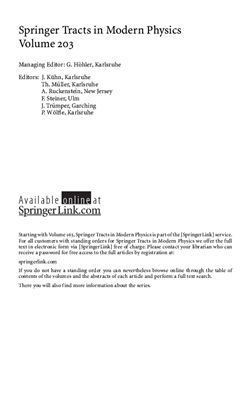Springer-Verlag Berlin, 2004, 175 pages
This book emerged from a long process of trying to write a monograph on the experimental and theoretical aspects of flavour physics, with some focus on heavy-flavour physics. This original scope tued out to be far too wide and had to be narrowed down in order to end up with a monograph of reasonable size. In addition, the field of flavour physics is evolving rapidly, theoretically as well as experimentally, and in view of this it is impossible to cover all the interesting subjects in an up-to-date fashion.
Thus the present book focuses on theoretical methods, restricting the possible applications to a small set of examples. In fact, the theoretical machinery used in flavour physics can be summarized under the heading of effective field theory, and some of the effective theories used (such as chiral perturbation theory, heavy-quark effective theory and the heavy-mass expansion) are in a very mature state, while other, more recent ideas (such as soft-collinear effective theory) are currently under investigation.
The book tries to give a survey of the methods of effective field theory in flavour physics, trying to keep a balance between textbook material and topics of current research. It should be useful for advanced students who want to get into active research in the field. It requires as a prerequisite some knowledge about basic quantum field theory and the principles of the Standard Model.
This book emerged from a long process of trying to write a monograph on the experimental and theoretical aspects of flavour physics, with some focus on heavy-flavour physics. This original scope tued out to be far too wide and had to be narrowed down in order to end up with a monograph of reasonable size. In addition, the field of flavour physics is evolving rapidly, theoretically as well as experimentally, and in view of this it is impossible to cover all the interesting subjects in an up-to-date fashion.
Thus the present book focuses on theoretical methods, restricting the possible applications to a small set of examples. In fact, the theoretical machinery used in flavour physics can be summarized under the heading of effective field theory, and some of the effective theories used (such as chiral perturbation theory, heavy-quark effective theory and the heavy-mass expansion) are in a very mature state, while other, more recent ideas (such as soft-collinear effective theory) are currently under investigation.
The book tries to give a survey of the methods of effective field theory in flavour physics, trying to keep a balance between textbook material and topics of current research. It should be useful for advanced students who want to get into active research in the field. It requires as a prerequisite some knowledge about basic quantum field theory and the principles of the Standard Model.

